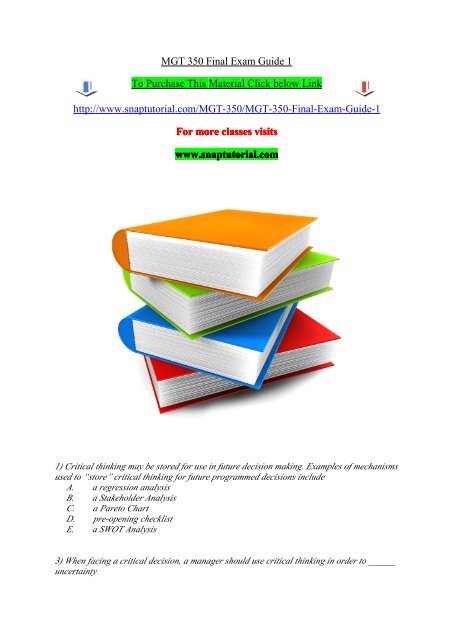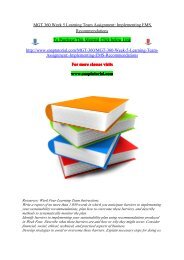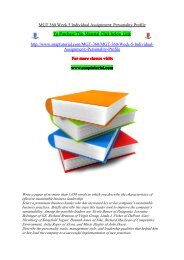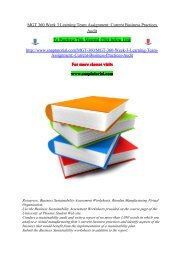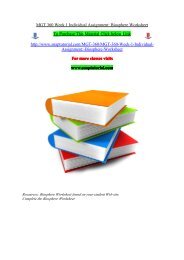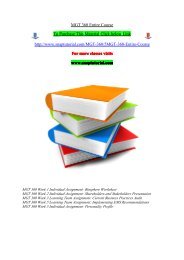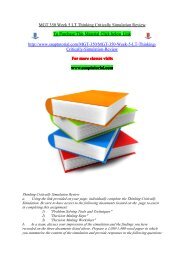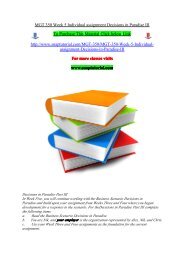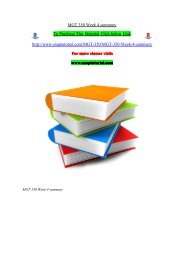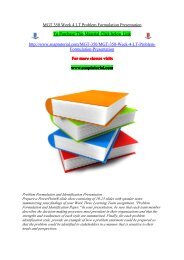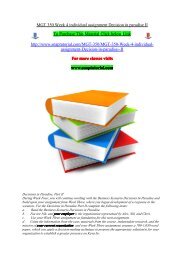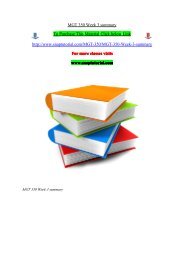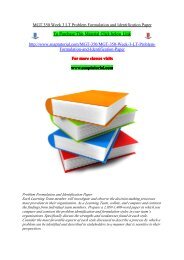MGT 350 Final Exam Guide 1/snaptutorial
For more classes visits www.snaptutorial.com 1) Critical thinking may be stored for use in future decision making. Examples of mechanisms used to “store” critical thinking for future programmed decisions include A. a regression analysis B. a Stakeholder Analysis C. a Pareto Chart D. pre-opening checklist E. a SWOT Analysis 3) When facing a critical decision, a manager should use critical thinking in order to ______ uncertainty A. eliminate B. increase C. reduce D. randomize 4) Kathy is a manager deciding between two applicants for a position reporting to her. One applicant for the position is a close personal friend of Kathy’s. Because Kathy is concerned that self serving bias may influence her to incorrectly see her friend as the best candidate, she should A. allow someone else to make the decision. B. eliminate her bias by not allowing her friend to apply C. ignore her bias and be strictly objective D. any of the above would be an equally valid choice from a critical thinking perspective E. seek input from others before making the decision. 5) Jane has a term paper due, a sick child who needs her attention, and a major project due at work. To save time, she decides to submit a paper for school that is less than her best, but will earn a passing grade. The best description of Jane’s approach is A. creativity B. analyzing C. satisficing D. optimizing 6) Despite all the measures followed, successful decisions are not always guaranteed so it is important to A. develop contingency plans B. only allow the most senior leaders to influence decisions C. use logical thinking to guarantee a correct outcome D. accept that some decisions will not work and move on to other issues E. develop appropriate measurements for the impacts of decisions 7) One way for a leader to develop alternative perspectives for decision making is to A. increase the use of the logical thinking style
For more classes visits
www.snaptutorial.com
1) Critical thinking may be stored for use in future decision making. Examples of mechanisms used to “store” critical thinking for future programmed decisions include
A. a regression analysis
B. a Stakeholder Analysis
C. a Pareto Chart
D. pre-opening checklist
E. a SWOT Analysis
3) When facing a critical decision, a manager should use critical thinking in order to ______ uncertainty
A. eliminate
B. increase
C. reduce
D. randomize
4) Kathy is a manager deciding between two applicants for a position reporting to her. One applicant for the position is a close personal friend of Kathy’s. Because Kathy is concerned that self serving bias may influence her to incorrectly see her friend as the best candidate, she should
A. allow someone else to make the decision.
B. eliminate her bias by not allowing her friend to apply
C. ignore her bias and be strictly objective
D. any of the above would be an equally valid choice from a critical thinking perspective
E. seek input from others before making the decision.
5) Jane has a term paper due, a sick child who needs her attention, and a major project due at work. To save time, she decides to submit a paper for school that is less than her best, but will earn a passing grade. The best description of Jane’s approach is
A. creativity
B. analyzing
C. satisficing
D. optimizing
6) Despite all the measures followed, successful decisions are not always guaranteed so it is important to
A. develop contingency plans
B. only allow the most senior leaders to influence decisions
C. use logical thinking to guarantee a correct outcome
D. accept that some decisions will not work and move on to other issues
E. develop appropriate measurements for the impacts of decisions
7) One way for a leader to develop alternative perspectives for decision making is to
A. increase the use of the logical thinking style
- No tags were found...
Create successful ePaper yourself
Turn your PDF publications into a flip-book with our unique Google optimized e-Paper software.
<strong>MGT</strong> <strong>350</strong> <strong>Final</strong> <strong>Exam</strong> <strong>Guide</strong> 1<br />
To Purchase This Material Click below Link<br />
http://www.<strong>snaptutorial</strong>.com/<strong>MGT</strong>-<strong>350</strong>/<strong>MGT</strong>-<strong>350</strong>-<strong>Final</strong>-<strong>Exam</strong>-<strong>Guide</strong>-1<br />
For more classes visits<br />
www.<strong>snaptutorial</strong>.com<br />
1) Critical thinking may be stored for use in future decision making. <strong>Exam</strong>ples of mechanisms<br />
used to “store” critical thinking for future programmed decisions include<br />
A. a regression analysis<br />
B. a Stakeholder Analysis<br />
C. a Pareto Chart<br />
D. pre-opening checklist<br />
E. a SWOT Analysis<br />
3) When facing a critical decision, a manager should use critical thinking in order to ______<br />
uncertainty
A. eliminate<br />
B. increase<br />
C. reduce<br />
D. randomize<br />
4) Kathy is a manager deciding between two applicants for a position reporting to her. One<br />
applicant for the position is a close personal friend of Kathy’s. Because Kathy is concerned<br />
that self serving bias may influence her to incorrectly see her friend as the best candidate,<br />
she should<br />
A. allow someone else to make the decision.<br />
B. eliminate her bias by not allowing her friend to apply<br />
C. ignore her bias and be strictly objective<br />
D. any of the above would be an equally valid choice from a critical thinking<br />
perspective<br />
E. seek input from others before making the decision.<br />
5) Jane has a term paper due, a sick child who needs her attention, and a major project due<br />
at work. To save time, she decides to submit a paper for school that is less than her best, but<br />
will earn a passing grade. The best description of Jane’s approach is<br />
A. creativity<br />
B. analyzing<br />
C. satisficing<br />
D. optimizing<br />
6) Despite all the measures followed, successful decisions are not always guaranteed so it is<br />
important to<br />
A. develop contingency plans<br />
B. only allow the most senior leaders to influence decisions<br />
C. use logical thinking to guarantee a correct outcome<br />
D. accept that some decisions will not work and move on to other issues<br />
E. develop appropriate measurements for the impacts of decisions<br />
7) One way for a leader to develop alternative perspectives for decision making is to<br />
A. increase the use of the logical thinking style<br />
B. rely on the intellectual component of stereotyping<br />
C. apply past decision successes to current decision opportunities<br />
D. increase the homogeneity of his or her team<br />
E. consult with internal stakeholders in other departments<br />
8) One way for a leader to develop alternative perspectives for decision making is to<br />
A. assign the role of devil’s advocate for meetings<br />
B. rely on the intellectual component of stereotyping<br />
C. apply past decision successes to current decision opportunities<br />
D. increase the homogeneity of his or her team<br />
E. increase the use of the logical thinking style
9) Critical thought involves the consideration of diverse perspectives. Disadvantages of<br />
group decision making include<br />
A. a decision that accounts for the interests of diverse stakeholders<br />
B. all of the above are disadvantages of group decision making<br />
C. a more autocratic environment<br />
D. a process that is more time consuming<br />
E. increased security of confidential information<br />
10) During problem formulation, the decision maker must account for the interests of diverse<br />
stakeholders. An important step toward this outcome is the establishment of<br />
A. measurements for the decision<br />
B. decision Implementation Processes<br />
C. criteria, goals, and objectives<br />
D. timelines and resource allocations<br />
E. contingency plans<br />
11) The outcome of the process of framing the problem includes<br />
A. a timeline for decision implementation<br />
B. an assessment of resources needed to execute a decision<br />
C. a list of criteria, goals, and objectives for a decision<br />
D. a list of potential alternative courses of action<br />
E. the measurements one will use to evaluate the decision<br />
12) Conflict is a force of influence upon decision making, and may hamper decision<br />
implementation if not accounted for in the problem formulation and identification process.<br />
Conflict may stem from such factors as<br />
A. inspirational leadership<br />
B. routine programmed decisions<br />
C. groupthink<br />
D. personal attributes<br />
E. a lack of a devil’s advocate<br />
13) What is the most comprehensive definition of a problem?<br />
A. A positive situation that requires action in order to fully leverage an opportunity.<br />
B. A declining economy resulting in reduced revenues<br />
C. A negative situation that requires action to mitigate damage<br />
D. Gap between current situation and some future desired state<br />
E. An increase in the cost of doing business.<br />
14) This thinking style may be used to frame a problem in general terms through the use of<br />
sample data.
15) A form of critical thinking is fair-minded persuasive thinking. When engaging in problem<br />
formulation and identification with a group, the fair minded persuader would<br />
16) While this decision style offers an opportunity for stakeholder input, it most lessens<br />
accountability for decision making.<br />
A. Democratic<br />
B. Consensus<br />
C. Autocratic<br />
D. Collaborative/participative<br />
E. Leader decides<br />
17) An appropriate profit relative to funds invested would be a primary consideration of this<br />
stakeholder group.<br />
18) Problems may become apparent to stakeholders through the use of tools which compare<br />
actual results to expected results. An example of such a tool is a<br />
he store’s commission structure for sales personnel. She has decided to exclude the sales<br />
personnel affected from the decision making process. Jan is probably seeking to minimize this<br />
force of influence on the decision making process.<br />
20) Identifying programmed decision opportunities—problems with objectively correct<br />
answers, solvable through the use of simple rules, policies, or numerical computations—<br />
promises this benefit in terms of decision making.<br />
21) Identifying programmed decision opportunities—problems with objectively correct<br />
answers, solvable through the use of simple rules, policies, or numerical computations—<br />
promises this benefit in terms of decision making.<br />
22) For urgent decisions, this approach may be the most efficient and effective use of the<br />
manager’s time when there are other critical competing priorities.<br />
A. Experimenting<br />
B. Optimizing<br />
C. Satisficing<br />
D. Brainstorming and multi-voting with a team<br />
E. Creation of a task force<br />
23) A decision tool that can be helpful in identifying risks to contemplated decisions is<br />
A. a Force Field Analysis<br />
B. a histogram<br />
C. a Pareto chart<br />
D. a periodic table<br />
E. a Fishbone diagram
24) When a manager is attempting to identify root causes, the following tool may be helpful:<br />
A. SWOT analysis<br />
B. Fishbone diagram<br />
C. Force field analysis<br />
D. profit and loss statements<br />
E. Financial Balance sheet<br />
25) The manager of the Gallery Restaurant noted that the restaurant had experienced a<br />
decrease in the number of evening customers. The manager promptly ordered the chef to<br />
rewrite the evening menu. Customer feedback later indicated that the problem had not been<br />
the menu but poor service from the wait staff. The manager's decision to have the menu<br />
revised suggests that she failed to<br />
A. properly diagnose the cause of the problem<br />
B. identify the problem<br />
C. evaluate the decision and its consequences<br />
D. evaluate the alternatives and consequences<br />
26) In the course of developing a SWOT analysis, Bob determines that a large competitor is<br />
moving into one of his company’s key service areas. Bob has uncovered<br />
A. a weakness<br />
B. a positive trigger point<br />
C. a strength<br />
D. a threat<br />
E. an opportunity<br />
27) When deciding between decision alternatives, this tool helps the manager to focus scarce<br />
resources on the most common causes of a problem.<br />
28) The best way to mitigate employee resistance to a decision is to<br />
29) Freda is in the process of implementing a significant decision. Which of the following<br />
considerations should she ignore?<br />
31) Freda is analyzing the prospects for a new gambling casino that her company is<br />
considering. In the course of her analysis, Freda has identified potential stakeholder<br />
resistance to this venture, in that she has discovered that the areas is very densely populated<br />
with houses of worship. She has also discovered a potential source of support for this venture,<br />
in that the local government has established tax credits for new businesses in an effort to<br />
stimulate employment. Freda is, in all likelihood, developing a<br />
32) The assignment of different tasks to different people or groups is an important part of a(n)
33) Since unforeseen circumstances will arise during implementation, a company should<br />
invest resources in teaching employees to<br />
A. be consistent in their actions<br />
34) The moral principles and standards that guide behavior in the world of business are<br />
called<br />
35) A system of rules that governs the ordering of values is referred to as<br />
36) Markus worked last summer as a receptionist in a lawyer's office. During a discussion<br />
prompted by the ethics chapter in your text, he commented that he was asked to tell callers<br />
that the lawyer was in court when in fact the lawyer was playing golf! He eventually quit the<br />
job because he believes that under no circumstance is it permissible to tell a lie. Markus<br />
appears to be following the ethical system referred to as a<br />
37) Bob’s company regularly surveys employees concerning satisfaction with various<br />
attributes of their jobs, and their working conditions. This allows Bob to watch for positive or<br />
negative changes in measured satisfaction levels when decisions are made to change the<br />
nature of work or compensation in order to increase retention. Bob is applying this thinking<br />
style to evaluate his decisions.<br />
38) The objective to “reduce rework significantly within 6 months” is not sufficiently<br />
meaningful nor measurable because it is not sufficiently<br />
39) A measurement that evaluates the amount of inputs used to achieve outputs is a measure<br />
of<br />
40) When evaluating the decision processes in an organization, leaders will bear in mind that<br />
41) When evaluating the decision processes in an organization, leaders should consider<br />
doing which of the following?<br />
42) As noted in our texts, a key measurement of our decisions is: “are they ethical.” In order<br />
to achieve a superior level of ethical behavior in its decision making processes, leaders<br />
should instill a(n) ______ in those charged with making decisions.


